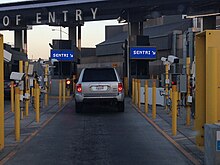This article may rely excessively on sources too closely associated with the subject, potentially preventing the article from being verifiable and neutral. (April 2019) |


The Secure Electronic Network for Travelers Rapid Inspection (SENTRI) provides expedited U.S. Customs and Border Protection (CBP) processing, at the U.S.-Mexico border, of pre-approved travelers considered low-risk. Voluntarily applicants must undergo a thorough background check against criminal, customs, immigration, law enforcement, and terrorist databases; a 10-fingerprint law enforcement check; and a personal interview with a CBP Officer. The total enrollment fee is $120.00, and SENTRI status is valid for 5 years.
Once the applicant is approved, they are issued a Radio Frequency Identification (RFID) card identifying their status in the CBP database when arriving at U.S. land and sea ports of entry (POE). SENTRI users have access to dedicated lanes into the United States.[1][2] Unlike NEXUS, which is a joint program between United States and Canadian immigration authorities, SENTRI is solely a CBP program and only applies to customs and immigration inspections into the United States, not into Mexico. SENTRI members are permitted to utilize NEXUS lanes when entering the United States from Canada by land (but not vice versa).[3]
Global Entry allows registered users to enter their own SENTRI applications and approved members to edit their information. A valid SENTRI card is a Western Hemisphere Travel Initiative (WHTI) compliant document.
- ^ "Secure Electronic Network for Travelers Rapid Inspection (SENTRI)". CBP.gov. November 1, 2006.[permanent dead link]
- ^ "Benefits of SENTRI | U.S. Customs and Border Protection". www.cbp.gov. 2020-09-01. Retrieved 2023-09-28.
- ^ "SENTRI FAQs". CBP.gov. p. 2. Archived from the original on 2009-10-17. Retrieved 2010-08-12.